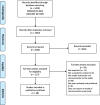Health authorities' health risk communication with the public during pandemics: a rapid scoping review
- PMID: 34266403
- PMCID: PMC8280576
- DOI: 10.1186/s12889-021-11468-3
Health authorities' health risk communication with the public during pandemics: a rapid scoping review
Abstract
Background: Responses from the H1N1 swine flu pandemic and the recent COVID-19 coronavirus pandemic provide an opportunity for insight into the role of health authorities' ways of communicating health risk information to the public. We aimed to synthesise the existing evidence regarding different modes of communication used by health authorities in health risk communication with the public during a pandemic.
Methods: We conducted a rapid scoping review. MEDLINE and EMBASE were searched for publications in English from January 2009 through October 2020, covering both the full H1N1 pandemic and the response phase during the COVID-19 pandemic. The search resulted in 1440 records, of which 48 studies met our eligibility criteria.
Results: The present review identified studies across a broad interdisciplinary field of health risk communication. The majority focused on the H1N1 pandemic and the COVID-19 pandemic. A content analysis of the studies identified three categories for modes of communication: i) communication channels, ii) source credibility and iii) how the message is communicated. The identified studies on social media focused mainly on content and engagement, while studies on the effect of the use of social media and self-protective behaviour were lacking. Studies on the modes of communication that take the diversity of receivers in the field into account are lacking. A limited number of studies of health authorities' use of graphic and audio-visual means were identified, yet these did not consider/evaluate creative communication choices.
Conclusion: Experimental studies that investigate the effect of health authorities' videos and messages on social media platforms and self-protective behaviour are needed. More studies are needed across the fields of health risk communication and media studies, including visual communication, web design, video and digital marketing, at a time when online digital communication is central to reaching the public.
Keywords: COVID-19; H1N1; Health communication; Media communication; Pandemic; Risk communication.
© 2021. The Author(s).
Conflict of interest statement
The authors declare that they have no competing interests.
Figures
References
-
- Porta M. A dictionary of epidemiology. USA: Oxford university press; 2014.
Publication types
MeSH terms
LinkOut - more resources
Full Text Sources
Medical
Miscellaneous



